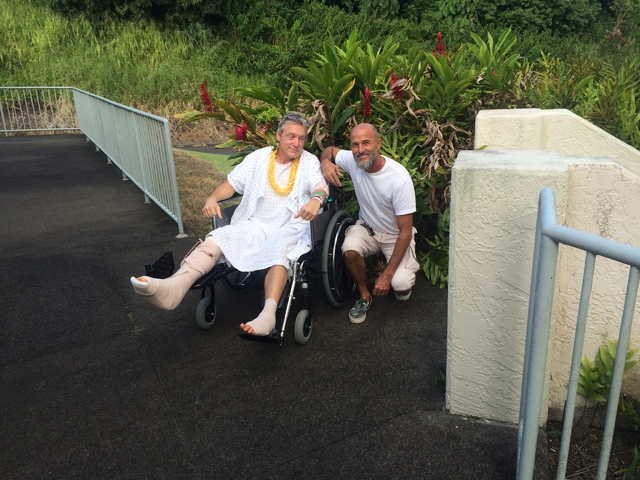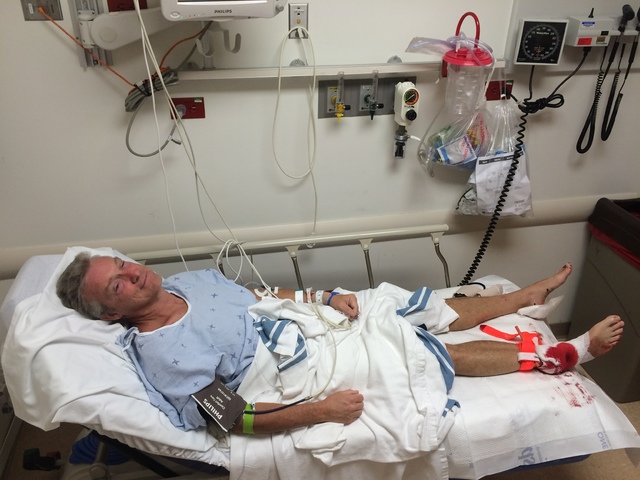On Tuesday morning, Paul O’Leary was making good time on one of his regular swims at Kehena Beach when he suddenly felt like he had caught his right foot on something under water.
On Tuesday morning, Paul O’Leary was making good time on one of his regular swims at Kehena Beach when he suddenly felt like he had caught his right foot on something under water.
It wasn’t until the 54-year-old got out of the water that he learned he had become another statistic in an unusually grisly year for shark attacks in Hawaii.
O’Leary said he swims almost every day at the lower Puna beach, known for its free-spirited drum circles and clothing-optional dress code. A relatively new transplant to Mountain View from New Mexico, O’Leary quickly adopted Kehena local tradition by taking his morning 1.5-hour swims wearing nothing but a pair of goggles and swim paddles on his hands.
“If you’ve never gone swimming nude, you gotta try it. You feel very free. … There’s very little resistance,” he said to a group of journalists in a conference room at Hilo Medical Center, where he is recovering from a nasty gash on his ankle that required more than 50 sutures and the repair of two torn tendons. Several nerves leading to his foot also were severed.
O’Leary says he was about 150 yards off shore in murky water when he felt his foot “scrape on something.”
“I didn’t think it was a bite at first,” he said. “… I never saw the shark.”
There was no pain, but he felt his calf muscle cramp up, and he could no longer control his foot as he was swimming. He called for help, because he didn’t know if he could swim back to shore in the strong current and heavy swells.
“I didn’t hear him call for help, but I did hear him yelling,” said Richard Dingman, 53.
A resident who has lived just three blocks from the beach for the last decade, Dingman said the two had just met each other at the beach the day before.
Dingman said that as he looked out toward O’Leary from his spot near the beach, he could tell something was wrong.
“He had his head up, out of the water. He looked distressed. It looked like he was trying to get away from something. I’ve actually been aware of all that’s been going on with the shark attacks in Hawaii. … I remember thinking it could be a shark,” he said. “I was looking for a dorsal fin or something.”
Despite his fears, Dingman, who had also been swimming au naturel, swam out in the direction of O’Leary.
“I thought, ‘I have to go help my friend,’” he said of his decision.
When Dingman reached O’Leary, the first thing that struck him was how calm the man seemed.
“I didn’t hear a whimper out of him,” he said. “… It actually made me more worried. I thought maybe he was going out or something. But, no, he was just really calm.”
Dingman held onto O’Leary’s shoulders as he swam backward toward the shore. It was a long, strenuous and nerve- wracking swim.
“It took about 20 or 25 minutes,” O’Leary said. “The current was so strong. It kept pulling us out.”
Upon reaching the shore, the two men were exhausted. But not so exhausted as to ignore decorum.
“I asked for my pants,” O’Leary said with a laugh. “I didn’t want to not have clothes on when the ambulance got there.”
Shortly after getting out of the water, the extent of the damage to O’Leary’s foot became clear.
“It was a pretty good laceration. You could see the puncture wound where the tooth went in,” he said. “That was when I started to realize, ‘I think I got bit.’”
State officials later confirmed that his injuries were indeed consistent with a shark bite.
As he recounted the story Thursday morning from a wheelchair, with his heavily bandaged foot elevated in front of him, O’Leary tried to play off the extent of the wound.
“It wasn’t really that bad,” he said.
“No,” corrected his friend Dingman. “It was bad. It was, like, hanging off. You could see bone.”
About four or five other people on the beach approached to offer help, putting pressure on the wound and dressing it. Located at the bottom of a steep, rocky incline, Kehena is notorious for its poor cellphone reception. But luckily, the men said, an emergency call box was installed at the entrance to the beach park in just the past year, and they were able to call for help.
Himself an employee of HMC as a medical lab scientist, O’Leary said his doctors expect him to make a full recovery after some physical therapy, and he offered his thanks to “everyone who helped me. I appreciate everything they did for me.”
As for his morning swims, O’Leary says he expects they will continue, although he plans on skipping the days when the water is murky.
“I don’t think I’ll be going again when it’s like that,” he said.
Email Colin M. Stewart at cstewart@hawaiitribune-herald.com.


